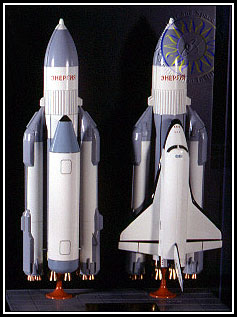
|
BURAN:
A SOVIET SPACE PLANE
In
the Soviet Union, interest in a reusable space plane began in the
1950s. After several incomplete design projects, the Soviets revived
the effort in the 1980s. At the time of the early U.S. Space Shuttle
launches, the Soviets were testing an unmanned scale model shuttle.
In
1983 the Australian Air Force caught this rare glimpse of early
Soviet shuttle development. The photograph shows the recovery of
the BOR-4 (Unpiloted Orbital Rocket Plane) test vehicle.
Courtesy
of the Royal Australian Air Force and the Griffith Observatory
|
|
BURAN
The
Soviet Union launched its first full-scale reusable space shuttle,
Buran ("Snowstorm"), on November 15, 1988. Although Buran
was tested extensively in the atmosphere with trained pilots, the
first and only orbital flight was made without a crew.
Buran
was launched by Energia, the largest Soviet launch vehicle. Two
Burans were manufactured, but after the sole unpiloted mission,
the program was canceled.
Courtesy
of Art Dula
|
|
BURAN
AND ENERGIA
Boris
Yeltsin, the first democratically elected president of Russia, presented
these models of the Soviet Buran spacecraft and Energia launch vehicle
to the Smithsonian in 1992 to commemorate the first launches of
Energia in 1987 and Buran in 1988.
Gift of
the Russian Federation
|

SI#: 97-16270-2 |
|
OPPOSITION
TO BURAN
Not
everyone in the Soviet space community was pleased with the decision
to develop a reusable space shuttle. Many scientists and engineers
felt that Buran would detract from already well-established and
successful space programs.
In
this letter to Soviet General Secretary Mikhail Gorbachev, dated
a month after the launch of Buran, Soviet engineer and cosmonaut
Konstantin Feoktistov outlined his own, largely financial arguments
against proceeding with the program.
Courtesy
of Emmet, Toni, and Tessa Stephenson
|
|
|